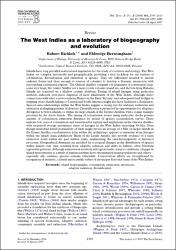Mostrar el registro sencillo del ítem
The West Indies as a laboratory of biogeography and evolution
| Autor | Ricklefs, Robert | |
| Autor | Bermingham, Eldredge | |
| Fecha de admisión | 2024-08-27T19:03:53Z | |
| Fecha disponible | 2024-08-27T19:03:53Z | |
| Año | 2007 | |
| Citación | Ricklefs, R., & Bermingham, E. (2008). The West Indies as a laboratory of biogeography and evolution. Philosophical Transactions of the Royal Society B: Biological Sciences, 363(1502), 2393-2413. Recuperado de: | es |
| URI | https://bvearmb.do/handle/123456789/5071 | |
| Sinopsis | Islands have long provided material and inspiration for the study of evolution and ecology. The West Indies are complex historically and geographically, providing a rich backdrop for the analysis of colonization, diversification and extinction of species. They are sufficiently isolated to sustain endemic forms and close enough to sources of colonists to develop a dynamic interaction with surrounding continental regions. The Greater Antilles comprise old fragments of continental crust, some very large; the Lesser Antilles are a more recent volcanic island arc, and the low-lying Bahama Islands are scattered on a shallow oceanic platform. Dating of island lineages using molecular methods indicates over-water dispersal of most inhabitants of the West Indies, although direct connections with what is now southern Mexico in the Early Tertiary, and subsequent land bridges or stepping stone islands linking to Central and South America might also have facilitated colonization. Species–area relationships within the West Indies suggest a strong role for endemic radiations and extinction in shaping patterns of diversity. Diversification is promoted by opportunities for allopatric divergence between islands, or within the large islands of the Greater Antilles, with a classic example provided by the Anolis lizards. The timing of colonization events using molecular clocks permits analysis of colonization–extinction dynamics by means of species accumulation curves. These indicate low rates of colonization and extinction for reptiles and amphibians in the Greater Antilles, with estimated average persistence times of lineages in the West Indies exceeding 30 Myr. Even though individual island populations of birds might persist an average of 2 Myr on larger islands in the Lesser Antilles, recolonization from within the archipelago appears to maintain avian lineages within the island chain indefinitely. Birds of the Lesser Antilles also provide evidence of a mass extinction event within the past million years, emphasizing the time-heterogeneity of historical processes. Geographical dynamics are matched by ecological changes in the distribution of species within islands over time resulting from adaptive radiation and shifts in habitat, often following repeatable patterns. Although extinction is relatively infrequent under natural conditions, changes in island environments as a result of human activities have exterminated many populations and others—especially old, endemic species—remain vulnerable. Conservation efforts are strengthened by recognition of aesthetic, cultural and scientific values of the unique flora and fauna of the West Indies. | es |
| Idioma | English | es |
| Publicado | Philosophical Transactions of the Royal Society B: Biological Sciences, 363(1502), 2393-2413 | es |
| Derechos | © 2007 The Royal Society. Available at: https://pubmed.ncbi.nlm.nih.gov/17446164 | es |
| Materia | Biodiversidad | es |
| Materia | Biogeografía | es |
| Materia | Hábitats y especies | es |
| Materia | Especies amenazadas o en peligro de extinción | es |
| Materia | Especies extintas | es |
| Materia | Flora | es |
| Materia | Fauna | es |
| Título | The West Indies as a laboratory of biogeography and evolution | es |
| dc.identifier.doi | https://doi.org/10.1098%2Frstb.2007.2068 | |
| Tipo de material | Article | es |
| Tipo de contenido | Scientific research | es |
| Acceso | Open | es |
| Audiencia | Technicians, professionals and scientists | es |
Ficheros en el ítem
Este ítem aparece en la(s) siguiente(s) colección(es)
-
Investigación ambiental [1759]


